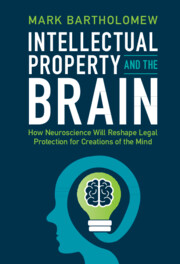 Intellectual Property and the Brain
Intellectual Property and the Brain from Part III - Using Neuroscience to Improve Intellectual Property Law
Published online by Cambridge University Press: 14 July 2022
Courts and scholars need to be judicious in translating the lessons of consumer neuroscience into new trademark doctrine. The chapter begins by cautioning against the motivated use of science in the courtroom, using the introduction of trademark survey evidence from trained psychologists in the early 1900s as a cautionary tale. Psychologists recognize two models of consumer reasoning: an automatic, emotional model and a deliberative, cognitive model. Neuroscience offers a window into both processes, but courts should be wary of admitting evidence purporting to measure non-deliberative changes in mark meaning. Trademark law has historically limited its remit to the informational components of advertising, in part because changes in a brand’s emotional meaning have been difficult to calculate. Neuroscientific evidence of these changes may now be available, but using them to decide trademark cases could lead to anti-competitive outcomes.
To save this book to your Kindle, first ensure no-reply@cambridge.org is added to your Approved Personal Document E-mail List under your Personal Document Settings on the Manage Your Content and Devices page of your Amazon account. Then enter the ‘name’ part of your Kindle email address below. Find out more about saving to your Kindle.
Note you can select to save to either the @free.kindle.com or @kindle.com variations. ‘@free.kindle.com’ emails are free but can only be saved to your device when it is connected to wi-fi. ‘@kindle.com’ emails can be delivered even when you are not connected to wi-fi, but note that service fees apply.
Find out more about the Kindle Personal Document Service.
To save content items to your account, please confirm that you agree to abide by our usage policies. If this is the first time you use this feature, you will be asked to authorise Cambridge Core to connect with your account. Find out more about saving content to Dropbox.
To save content items to your account, please confirm that you agree to abide by our usage policies. If this is the first time you use this feature, you will be asked to authorise Cambridge Core to connect with your account. Find out more about saving content to Google Drive.